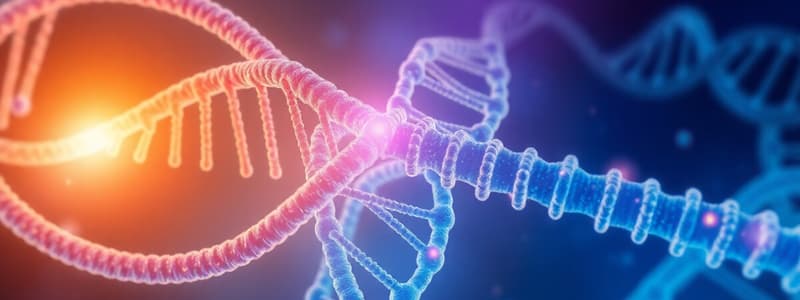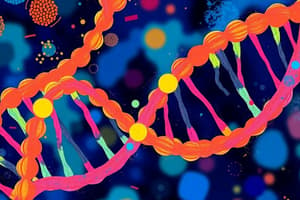Podcast
Questions and Answers
What is the primary conclusion of the Hershey and Chase experiment?
What is the primary conclusion of the Hershey and Chase experiment?
- Nucleotides provide energy for replication.
- RNA is responsible for protein production.
- DNA is the genetic material in bacteria. (correct)
- Proteins determine the genetic traits of an organism.
Which enzyme is primarily responsible for adding nucleotides during DNA replication?
Which enzyme is primarily responsible for adding nucleotides during DNA replication?
- DNA polymerase III (correct)
- Helicase
- Primase
- Topoisomerase
Which of the following describes the leading strand during DNA replication?
Which of the following describes the leading strand during DNA replication?
- It cannot be synthesized in an antiparallel fashion.
- It requires multiple primers for synthesis.
- It is synthesized discontinuously.
- It is synthesized continuously towards the replication fork. (correct)
What is the role of the TATA box in transcription?
What is the role of the TATA box in transcription?
What is a frame shift mutation?
What is a frame shift mutation?
What is the primary function of telomerase?
What is the primary function of telomerase?
Which statement accurately compares prokaryotic and eukaryotic transcription?
Which statement accurately compares prokaryotic and eukaryotic transcription?
Which part of the DNA structure did Chargaff's rule help to clarify?
Which part of the DNA structure did Chargaff's rule help to clarify?
Flashcards
Semiconservative DNA replication
Semiconservative DNA replication
Each new DNA molecule consists of one original strand and one new strand.
Leading vs. Lagging Strand
Leading vs. Lagging Strand
Leading strand replicates continuously; lagging strand replicates discontinuously in short fragments (Okazaki fragments).
Transcription
Transcription
DNA information is copied to RNA (mRNA).
RNA Splicing
RNA Splicing
Signup and view all the flashcards
Point Mutation
Point Mutation
Signup and view all the flashcards
Silent Mutation
Silent Mutation
Signup and view all the flashcards
mRNA
mRNA
Signup and view all the flashcards
Codons
Codons
Signup and view all the flashcards
Study Notes
Chapter 16: Molecular Basis of Inheritance
- DNA discovery and structure
- Griffith and Avery experiment results and conclusions
- Hershey and Chase experiment results and conclusions
- Chargaff's rule
- X-ray diffraction of crystallized DNA (Watson and Crick contribution)
- DNA replication
- Semiconservative, antiparallel nature
- Origin of replication
- DNA polymerase III, DNA polymerase I, and DNA ligase (role)
- Leading versus lagging strand synthesis
- Repairing DNA by prokaryotes and eukaryotes
- Replication enzymes involved
- Telomeres and telomerase
- Organization of DNA
- Histone, nucleosome, chromatin
Chapter 17: From Gene to Protein
- One gene-one enzyme hypothesis (Srb and Horowitz)
- Transcription process and location
- RNA polymerase, promoter, terminator
- Transcription factors, TATA box
- Transcription unit
- Transcript processing
- 5' cap and poly A tail
- RNA splicing, introns, exons, spliceosome, and alternative splicing
- Translation
Chapter 19: Viruses
- Overview of viruses
- Introduction: non-living, structural components
- How do they differ from prokaryotes?
- Viral genome components
- Viral structure-Capsid and Envelopes
- Viral replication biology
- Host range determinants
Studying That Suits You
Use AI to generate personalized quizzes and flashcards to suit your learning preferences.




